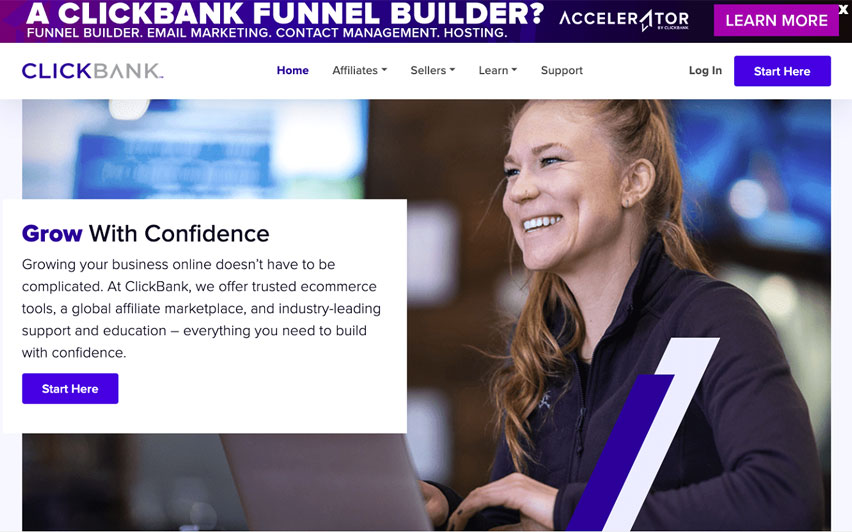What is Affiliate Marketing & How It Works
Is it worth the hype? In short: Yes! Learn what affiliate marketing is, how it works, and how you can get started with affiliate marketing in your business.

You have a great product. A really great product. But the unfortunate truth is that simply having a great product is not enough. You need to get the word out about it. To drive increased brand awareness without spending an exorbitant amount of money on your marketing campaigns. Put simply, you need to connect with customers who need your product.
Enter affiliate marketing.
Through an affiliate marketing program, you can have your product promoted to an audience much larger than your own. You can acquire customers without breaking the bank. You can build awareness of your product which will ultimately lead to more sales.
In this guide, we’ll walk you through what affiliate marketing is, how it works, why it’s worth the hype (can you say “pay per sale”?), and how you can get started with affiliate marketing in your business.
What Is Affiliate Marketing and How Does Affiliate Marketing Work?
Affiliate marketing is a digital marketing strategy where an individual or brand (the affiliate) forms partnerships to earn a commission for promoting your company’s products or services.
The affiliate is looking for some affiliate income (often passive income) and identifies a product they enjoy, promotes it through various channels, and earns a piece of the profit from each sale they make for you. You can track these sales via unique affiliate links from one website to another.
The grocery delivery platform FreshDirect, for example, has an affiliate program. They work with affiliates to promote their products and ultimately drive more signups.

Like with FreshDirect, every affiliate program involves four parties (affiliate partners):
The Merchant or Advertiser
That’s you. The Merchant, also known as the Advertiser, is the creator of the product or service. They could be a large company like Apple or a small online business selling handmade goods. In this case, the merchant is FreshDirect.
Merchants are the driving force behind the product but need help to get their offerings out into the world, which is where affiliates come in.
Affiliates can help merchants acquire customers for significantly less than they would through other online marketing channels. They can put a merchant’s product in front of a large audience that they wouldn’t have access to otherwise. Ultimately, affiliates can provide merchants with a significant boost in sales and revenue while also lowering Customer Acquisition Costs (CAC).
The Affiliate
The affiliate or publisher is the individual or company that convinces the consumer that the product is valuable.
The affiliate may promote FreshDirect on their website, through social media, via email, or any other number of ways. In most cases, the affiliate is given a unique link through which to promote the product or service.
This unique link allows you to determine how many sales an affiliate generates and to pay them accordingly.
The Consumer
As you know, consumers are the lifeblood of any affiliate marketing strategy. They’re the ones who see your product or service, click on the affiliate’s link, and make the purchase.
Affiliate marketing benefits all three parties involved. You, the merchant, get sales (and know who to attribute those sales – and future marketing budget – to), the affiliate gets commissions, and the consumer gets your valuable product or service, sometimes at a discounted rate.
The Network
The affiliate network is the platform that connects the merchant and the affiliate; they serve as a liaison. It is where sales are tracked and then paid out as commissions. The affiliate network helps affiliates and merchants find each other quickly and efficiently.
3 Types Of Affiliate Marketing
You’d be surprised how much content you encounter every day that is affiliate marketing.
While it’s a powerful tool, it’s not one-size-fits-all. There are three different types of affiliate marketing, each suited to different styles and objectives:
Unattached
With unattached affiliate marketing, the affiliate doesn’t need a strong connection with your product or service, and often, the consumer doesn’t even need to know who the affiliate is. It usually involves PPC (pay-per-click) advertising and less content creation.
Gimme Some Oven, for example, is a lifestyle, food, and travel blog. The ads on their blog are a form of unattached affiliate marketing since the author doesn’t have personal experience with the service (in this case, Marriott hotels) advertised.

The blogger isn’t necessarily endorsing the product—she’s just providing a space for the ad.
The advertiser (you) pays the blog owner to place the banner ad, and the blogger may earn a commission if a sale is made through that link.
Related
In related affiliate marketing, the affiliate has some connection to the product or service but isn’t necessarily using it.
They create content that aligns with their affiliate niche and includes affiliate links to products their audience might be interested in.
TechRadar, for example, is a technology news and reviews site that provides in-depth articles on the latest tech trends and products. While they review a wide range of products, like in the laptop buying guide below, they may not personally use every single one.

Their affiliate links still relate to their niche and audience interests, though.
Involved
Involved affiliate marketing is where the affiliate truly believes in your product or service they are promoting because they’ve used it and know it works.
They create honest, compelling content and product reviews based on their personal experiences and trust in the product.
For example, The Blonde Abroad is a travel blogger that posts content related to destinations and travel tips. On her affiliate site, she has a blog post on “10 Must-Have Travel Beauty Products” that includes reviews for products she’s tried.

This is the most demanding type of affiliate marketing. It requires you to find the right influencer who is willing to invest time into trying out your product and creating content reflecting their genuine views.
This is often called “influencer marketing.”
Want to breathe life into your Affiliate Program? We can help.
Consumers are the lifeblood of any affiliate marketing strategy. They’re the ones who see your product, click on the affiliate’s link, and make a purchase.
Common Types of Affiliates
Affiliate marketing isn’t confined to a single type of affiliate or even a single affiliate marketing channel. Depending on your audience, niche, and style, you can choose from several channels for your affiliate marketing efforts.
Mass Media Sites
Mass media sites are authoritative websites with significant traffic. They cover a broad range of topics and can affect product sales due to their wide reach.
For example, sites like BuzzFeed often feature ecommerce product recommendations with embedded affiliate links. These types of posts are often called “Performance PR” or “premium content.”

Their broad readership means these sites can drive traffic to a merchant’s site and boost affiliate earnings. This form of content marketing often relies on organic search engine traffic and SEO to drive results.
 Influencers
Influencers
Influencers or content creators have built a substantial and engaged following on social media platforms, podcasts, blogs, etc. They often focus on creating quality content for a specific niche, such as fitness, fashion, or food, and their followers trust their recommendations.
For instance, fitness influencer Stefana Avara promotes workouts and nutritional food she uses to her million followers on TikTok.
Her followers, already invested in her fitness journey, are likely to trust her recommendations and make a purchase through her affiliate links.
Coupon & Loyalty Sites
Coupon sites and loyalty sites attract consumers looking for deals and discounts. They offer the consumer some sort of incentive, be it deals and coupons or points and cashback. By providing coupon codes and special discounts, these sites can drive substantial affiliate sales for companies while earning affiliate commissions.
Rakuten Rewards and Capital One Shopping are great examples of loyalty sites, and RetailMeNot and Groupon are prime examples of coupon sites, offering deals across a wide range of products and services.

When a consumer uses a coupon from these sites, it usually involves an affiliate link, generating revenue for the coupon site.
Customers that use these sites are searching for the products or services you offer, but they’re ultimately looking for the best deal they can find. If your competitors are on a coupon site and you’re not, you’re going to end up losing sales to them.
Email Marketing
An email list allows affiliates to promote content, products, or services. They can earn commissions from their subscriber base by promoting affiliate products within their newsletters or dedicated promotional emails.
For example, Katelyn Bourgoin, founder of Customer Camp, a global education and media company that helps companies with customer insights, partnered with PostPilot for the latest issue of her newsletter.

81% of respondents in a study have either researched, purchased or considered purchasing a product or service after seeing friends, family or influencers post about it.
How Do Affiliate Marketers Make Money?
Earnings from affiliate marketing can vary widely.
In a study by Influencer Marketing Hub, around 17% of respondents earned more than $50,000 annually, while top earners can make more than $150,000 a year.
Still, most make below $10,000 a year, which is why, for many, affiliate marketing is more of a side hustle.

These earnings often come in the form of commissions, ranging from as low as 1% to as high as 50% or more, depending on the product, industry, and specific affiliate program.
Several factors can affect these earnings, such as the industry, the commission structure, the product price, the conversion rate, and the volume of traffic they can attract.
For example, the same study showed that SaaS-based products have commissions ranging from 20% to 70%, while fitness product commissions vary between 10% to 20%.
Let’s break down the main commission structures used in affiliate marketing:
Per Sale
Pay per sale is the most common affiliate marketing structure.
In this program, you pay the affiliate a percentage of the product’s sale price after a customer buys the product with the affiliate marketer’s promotion.
If an affiliate promotes a $200 watch with a 10% commission rate, they would earn $20 for each watch sold through their affiliate link.
Per Click
In per-click programs, you pay the affiliate based on the number of visitors they send to your website, regardless of whether a sale is made.
A travel blogger, for example, could get a certain amount for every user who clicks through an affiliate link to a hotel booking site. The focus here is to attract traffic to the merchant’s site. This is a great brand awareness play – and you can retarget these consumers with ads after they’ve left your site, creating return visitors and often return customers.
Per Lead
Here, the affiliate gets paid for the conversion of leads. The affiliate convinces the customer to visit the merchant’s website and complete an action like filling out a contact form, signing up for a product trial, or subscribing to a newsletter.
In the same way, a content creator on LinkedIn could earn a commission when a follower signs up for a free trial of a marketing tool using their link.
Per Install
This model is common in the tech industry, where the affiliate is paid for each app install that results from their marketing efforts. This might be a fixed fee or a percentage of the purchase price if the user upgrades to a paid version.
For example, a tech blogger could earn a commission each time a reader installs a recommended productivity app via their affiliate link.
How Does Affiliate Marketing Benefit Brands?
Affiliate marketing offers many pros for brands. Collaborating with affiliates allows brands to build their brand awareness, reach new audiences, and drive sales. Here’s how you can benefit:
Increased Brand Awareness
Affiliates can boost your brand’s visibility. Each time an affiliate shares your product with their target audience, they spread the word about your brand.
For example, a beauty brand might see a surge in brand recognition if a popular beauty blogger features their products in a makeup tutorial on their YouTube channel. The more affiliates you have, the wider your reach can potentially be.
Lower Customer Acquisition Cost (CAC)
Affiliate marketing is performance-based, which means you only pay for results. You’re usually spending money only when you gain a new customer or achieve a specific action, making it a low-cost and low-risk strategy for customer acquisition.
Imagine you sell a unique, innovative laptop stand. Partnering with affiliates who are also tech bloggers can help your product get featured in “Best Laptop Accessories of 2023” blog posts or YouTube videos.
These affiliates, through their established trust and rapport with their audience, drive sales and spread the word about your brand.
Increased Return On Ad Spend (ROAS)
Because you’re only paying for results, affiliate marketing can result in a higher Return On Ad Spend (ROAS) than other ad strategies.
For example, a brand selling kitchen appliances could offer affiliates a 10% commission on each sale. If an affiliate sells an appliance for $500, the brand would pay the affiliate $50. However, they’re still making $450 on a sale they might not have had without the affiliate, demonstrating a positive return on ad spend.
Customer Connections At Every Stage Of The Funnel
Affiliates can engage with consumers at all stages of the sales funnel. Providing valuable content and relevant product recommendations helps them attract potential customers, nurture leads, and drive conversions.
For example, a fitness influencer could write a blog post about the benefits of protein powders (awareness), compare different brands (consideration), and then recommend their favorite with an affiliate link (purchase). A variety of content guides readers through every stage of the funnel.
Ready to go further with Affiliate?
How Can Brands Get Started With Affiliate Marketing?
Are you a beginner? A step-by-step approach to affiliate marketing makes it more manageable. Here are two paths you could take:
Establish and Run Your Own Affiliate Program
Starting your affiliate program gives you complete control over every aspect, from setting the commission rates to deciding on the attribution model.
Starting from scratch requires you to build a platform where affiliates can sign up, access promotional materials, and track their performance metrics.
You’ll need to join affiliate networks—platforms that connect merchants (like you) with potential affiliates. Networks like ClickBank, CJ Affiliate, and Amazon Associates give you access to affiliates across various niches.

Running your own program also means that you can align the affiliate marketing efforts with your product release schedule. When you’re launching new products, for example, you can provide affiliates with exclusive information and promotional materials to create buzz among their followers.
Remember, tracking is critical in affiliate marketing. You’ll need to implement a reliable system to track referrals and ensure you properly credit affiliates for the sales they generate.
Is any of this sounding complicated or time-consuming? Well, it is. So, here’s a better option…
Hire An Agency To Run and Optimize Your Program
If establishing and running your affiliate program seems too daunting or resource-intensive, you can consider hiring an affiliate marketing agency like Gen3. Agencies have the expertise to manage and optimize your program and ensure it aligns with your business objectives.
Agencies can be especially useful for DTC retailers, as our affiliate managers can handle the operational complexities of running an affiliate program, leaving you to focus on your core business. They also have the experience necessary to identify and eliminate affiliate fraud and affiliate marketing scams.
We can recruit affiliates and manage payouts, among other responsibilities. We already have strong relationships with all major affiliate networks, which makes it easier to get quality affiliates on board. We also know how to negotiate better terms with these networks, given our volume of business.
Gen3 has been in the affiliate marketing business longer than any other agency – meaning we have access to mountains of data across multiple affiliate networks that we can leverage these insights on your behalf.
How to Get Started with Successful Affiliate Marketing
Choosing the right path depends on your specific situation—your resources, expertise, and business goals. But whether you choose to DIY or hire an agency, affiliate marketing can be a powerful tool.
Affiliate marketing has the potential to amplify your brand’s reach. It also allows you to connect with audiences you might not have had access to otherwise. But, it also requires strategic planning, careful execution, and constant optimization.
Which is why we’re here to help.
Decades of experience help us pinpoint what’s going right and what’s going wrong. Get in touch today and let’s maximize your brand’s reach.
Want to raise your ROAS and reduce your CAC? We can help!
More Blogs
Psychological Safety: How it Drives Better Marketing Solutions
Fostering an environment where team members feel psychologically and emotionally safe leads to better marketing outcomes.As agency work environments grow more flexible, workplace culture must evolve as well. For agencies, like Gen3 Marketing, who strive to deliver...
How AI & Voice Commerce Are Changing Affiliate Marketing
Artificial Intelligence (AI) and voice commerce are changing the affiliate marketing channel. Learn how you can capitalize on the new opportunities offered by these technologies.Artificial intelligence and voice commerce are transforming how consumers discover and...
How Long Does SEO Take?
Understanding the timeline for SEO success is essential. We dive into a typical SEO timeline, detailing key factors that affect outcomes.Every business considering SEO services for their brand and website asks the same (very reasonable) questions: How long does SEO...

 By
By 

